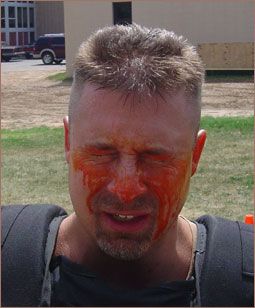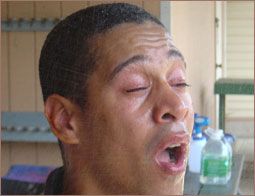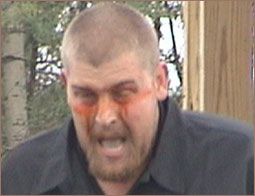Chemical aerosols are one of the most used and reliable force options inside a correctional facility. Throughout the last 17 years, they’ve given us a resonable expectation for results, and they’re easy to maintain and to deploy.
Effects of Chemical Aerosols
 |
When a subject is contaminated they will experience both a mental and physical effect of being contaminated from the aerosols. At times the mental effects can outlast and be more intense than the physical effects. Chemicals have been use throughout the world in many situations from training, distracting, disabling, but, more important, they are designed to create pauses in combat.
There are many phobias associated with being contaminated with chemicals. We see movies were people are helpless, or even knocked out rendered unconscious to where some show no signs of being overwhelmed or effected. The mere fact of being unable to control how they are feeling emotionally powerful and many times is responsible for the panic they feel. When you mix this with the anxiety that people have with the unknown and combine it with the fear people have in general losing the control, you can get many different types of responses and even panic.
When you add the mental effects a person will experience with the small physical effects they can be overwhelming at times, and often incapacitating for some. The effect may be either mental or physical, and in many cases, both.
One of the top human phobias in the world is the fear of not being able to breathe — suffocating, choking or gagging also factor into this. This fear is magnified when you combine the person’s inability to get control of their own breathing.
Facial burning is usually the first physical effect they feel. This normally occurs on the soft tissue of the eye lids, eyes itself and eye brows, facial area, cheeks, ears and neck usually any part of the skin the aerosol comes into contact with.
OC is classified as an inflammatory agent, meaning it swells the surface it comes into contact and causes duress to the mucus membranes causing the mucus to run from the nasal passages.
OC Myths
Here are a few questions on what OC really does:
 |
1. Does OC stop the aggression of a charging subject?
a. No, OC creates pauses in combat that will allow the officer the ability to evaluate the threat from the subject. These pauses in combat can be physical or mental or both.
2. Does OC incapacitate a subject?
a. No, OC affects people differently. Some will shut down while others get enraged, some experience respiratory effects greater then others where other show very little signs, some eyes will shut down others stay open!
3. Does OC burn your eyes closed?
a. No, OC is classified as an inflammatory chemical that OC does dry your eyes out and the solvents inside the OC formulation gives the physical impression that they are burning along with the facial area.
4. When I get sprayed with OC will my nose bleed?
a. Maybe, but not from the OC. Some people have very thin mucus membranes, or have a thin nasal layer which might become dry over time and the contact with the solvents may cause a nose to bleed.
5. Does OC give a person asthma?
a. No, OC may create an AXNIETY attack which in turn can create the impression shortness of breath, or bring on the feeling of an asthma attack to a person who ALREADY has asthma.
6. Does OC kill you?
 |
a. No, but anyone who has been contaminated with OC before can mistake it for the feeling of death, when, in fact, you won’t die. A few years after OC was first introduced to the law enforcement community in the early 1990’s there were a few subjects that died shortly after being contaminated with OC.
In the beginning, their deaths were thought to be contributed to positional asphyxia. Later, it was confirmed that OC had nothing to do with their deaths. OC will, however, unmask or uncover other pre-existing medical conditions that a subject may not be aware of. OC can also highlight the effects of other narcotics or other prescribed or un-prescribed medication they are taking. By itself, OC has not killed anyone!
7. Can OC give a person a heart attack?
a. No, OC can create difficulty in breathing giving the person a feeling of tightness in the chest, and unmask or uncover other preexisting medical conditions that a subject may not be aware of at the time. OC is the ONLY non-lethal weapon to that has not been responsible for killing anyone!
b. What determines a non-lethal weapon to be a “non-lethal” weapon? Is it the intended design? Intended use of that weapon, something to think about!
i. If you were to deploy/strike/spray/stun/shoot a person every minute on the hour for 24 hours, what would be the end result? Example:
1. If you were to use empty hands on a person and strike to the head every minute on the hour – would or could if result in death of that person?
2. If you were to use an impact weapon on a person and strike to the head every minute on the hour – would
3. If you were to shoot person with a firearm in the head every minute on the hour – would or could if result in death of that person?
8. Can I go blind from being sprayed with OC?
a. No, OC shuts the eyes and gives you an involuntary eye closure because the capsaicin dries the eyes out. This is temporary and effects last between 20-30 minutes on average.
b. The possibility of going blind from being sprayed with the type of OC that is designed for humans is very slim
to none, however, there are some chemical aerosol sprays that can be dangerous from the amount or types of solvents used or other hazardous ingredients inside the formulations like the ones used to stop or deter animals.
9. What does OC really do?
a. OC creates a temporary burning sensation to the skin of the facial area or other sensitive places on the skin by contact, enhances vision impairment by temporarily shutting the eyes down, and creates difficulty in breathing by the respiratory distress it induces.
b. These pauses in combat can overwhelm a subject to force them to comply with your verbal commands or in some cases, enrage them and make them more combative.












